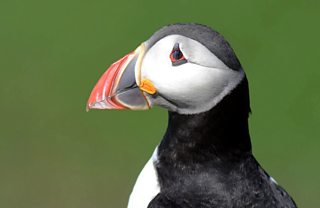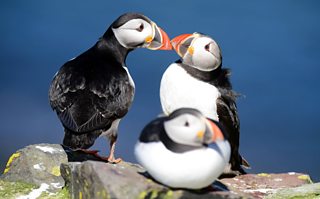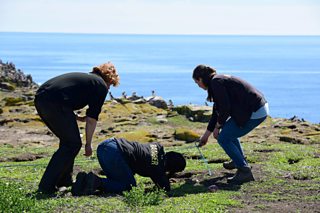By Gwen Potter, Countryside Manager for Northumberland Coast and Farne Islands, National Trust
It’s June on the remote Farne Islands and National Trust rangers have started the task of counting the islands’ thousands of pairs of puffins. The much-loved seabird, which has traditionally done well on these wild isles off the Northumberland coast, is being closely monitored amid fears climate change is having an adverse effect on sources of food and puffin numbers internationally.

Puffins are one of our most unique and charismatic birds. Photo by Paul Kingston/NNP.
The census involves teams of rangers assessing the puffins’ burrows for signs of life – and occasionally reaching inside to feel for an adult, chick or egg.
Previously, the survey took every place every five years but will now become an annual count. A downward trend in global numbers and worries about the reduction in quality and abundance of its preferred food source, the sandeel, as well as more frequent storms, have led to the decision to monitor the seabirds more closely.
Atlantic puffins have traditionally done well on the Farnes thanks to the work of the rangers, increasing protection of the marine areas around the islands, a lack of ground predators and the availability of suitable nesting areas.
The 2018 results revealed that puffin numbers were currently stable, increasing by around nine percent since 2013, from 39,962 to 43,956 pairs of birds. Although the numbers during the last five years have stabilised, the population is some way off its 2003 peak, when 55,674 pairs were recorded.

A pair of affectionate puffins on the Farne Islands. Photo by Paul Kingston/NNP.
Puffins nest on eight of the Farne Islands. Different methodologies are used to count the sea birds in the different areas.
The rangers are using a method called stratified random sampling on the 4 larger islands: Inner Farne, West Wideopen, Brownsman and Staple. They survey a sample of the burrows on these islands, superimposing 25m2 grid squares on the island and randomly selecting 30-50 grids. To count the burrows, they place a bamboo cane in the middle of each square and use a piece of rope to form a 20m circular quadrat.

Rangers on the Farne Islands survey the number of active burrows within a certain area. Photo by Paul Kingston/NNP.
Within each circular quadrat the rangers count every burrow and determine whether it is occupied or non-occupied, by assessing it visually. An occupied burrow will have signs of fresh digging, droppings, egg shells, fish or feather in the entrance. Non-occupied burrows tend to have overgrown vegetation at the entrance. If unsure, only then will they put their hands down to feel for an adult, chick or egg (the technique is called grubbing). From the samples of occupied burrows, they calculate the total for the whole island.
For the 4 smaller islands: North Wamses, South Wamses, East Wideopen and Big Harcar, rangers count every single burrow on the island.
This year’s census results will be published in the ‘Coastal Wildlife’ report at the end of the year. .
